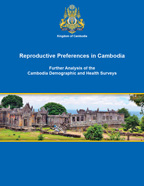- PUBLICATIONS
- JOURNAL ARTICLES
- ACCESS PUBLICATIONS
Publications Summary
- Document Type
- Further Analysis
- Publication Topic(s)
- Family Planning, Fertility and Fertility Preferences
- Country(s)
- Cambodia
- Survey
- Cambodia DHS, 2010
- Language
- English
- Recommended Citation
- Westoff, Charles F., Kristin Bietsch, and Rathavuth Hong. 2013. Reproductive Preferences in Cambodia: Further Analysis of the Cambodia Demographic and Health Surveys. DHS Further Analysis Reports No. 87. Calverton, Maryland, USA: ICF International.
- Download Citation
- RIS format / Text format / Endnote format
- Publication Date
- July 2013
- Publication ID
- FA87
